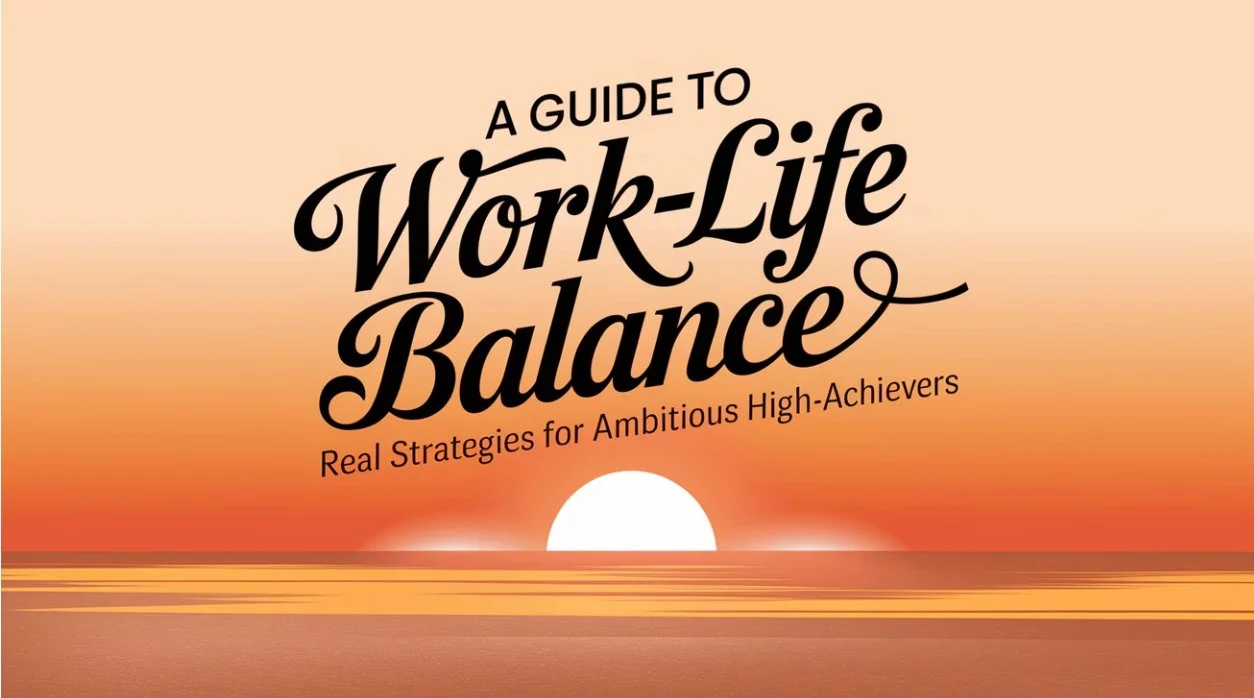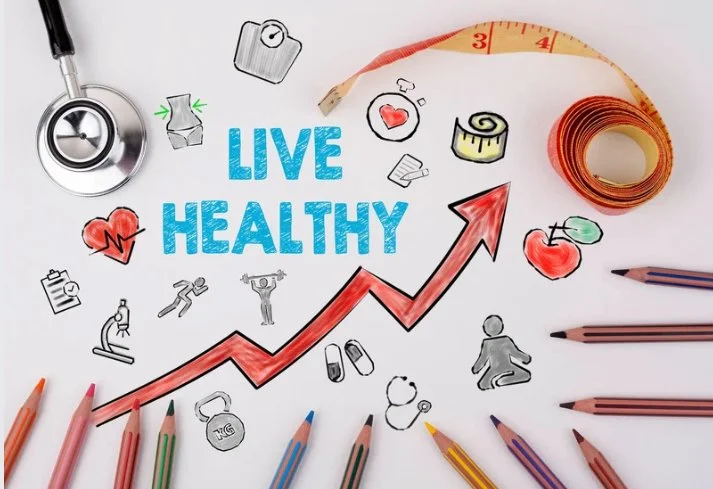A Guide to Work-Life Balance: Real Strategies for Ambitious High-Achievers
The High-Achiever's Dilemma
Let's be honest—if you're reading this, you've probably rolled your eyes at generic work-life balance advice before. As an ambitious professional, you don't just want to coast through life. You have big goals, a strong drive, and a genuine passion for what you do. The standard "leave work at 5 PM and take up knitting" advice feels disconnected from your reality.
I get it. The relationship between ambition and balance isn't straightforward. When you're wired to achieve, traditional balance can feel like settling or slowing down. But here's the truth I've learned coaching high-performers: balance isn't the enemy of achievement—it's the secret weapon.
The most successful leaders I work with aren't successful despite having boundaries—they're successful because of them. They've learned that sustainable high performance requires strategic recovery, intentional focus, and aligned priorities.
Redefining Balance for the Ambitious
First, let's clear something up. Work-life balance for high-achievers isn't about equal time distribution or separating your professional and personal identities. It's about creating a sustainable approach to success that honors all dimensions of who you are.
True balance means:
Integration, not separation – Finding ways your ambitions and personal life can enhance each other
Intentionality, not restriction – Making conscious choices about your energy and focus
Sustainability, not sacrifice – Building success that doesn't require burning yourself out
When we approach balance this way, it becomes a competitive advantage rather than a compromise.
Strategy 1: Design Your Personal Success Metrics
High-achievers often operate on externally defined success metrics—promotions, revenue targets, recognition. These are important, but they're insufficient on their own.
Define Your Non-Negotiables
What matters beyond professional achievement? Is it being present for family dinners four nights a week? Having energy for creative side projects? Maintaining your physical health? Being mentally present when you're off the clock?
Action step: Write down 3-5 non-negotiable components of your personally-defined success. These become your "balance benchmarks"—areas you refuse to sacrifice regardless of professional demands.
Audit Your Current Reality
How well are you honoring these non-negotiables now? Where are the biggest gaps between what you value and how you're living?
Most of my clients discover they've been unconsciously prioritizing urgency over importance, letting immediate demands override their deeper values.
Strategy 2: Master Energy Management (Not Just Time Management)
High-achievers are typically excellent at time management. The problem isn't that you don't know how to schedule—it's that you're trying to operate at peak performance constantly.
Energy Cycles vs. Time Blocks
Start tracking your natural energy patterns. When are you naturally most focused, creative, analytical? Schedule your most demanding work during your peak cognitive hours.
Research shows that our brains function in ultradian rhythms—roughly 90-minute cycles of high focus followed by needed recovery. Fighting these natural rhythms leads to diminishing returns.
Action step: For one week, track your energy levels hourly on a scale of 1-10. Look for patterns and restructure your schedule to align with your natural peaks.
.
Strategic Recovery
Recovery isn't a reward for hard work—it's a prerequisite for sustained performance. Elite athletes understand this; they build recovery into their training plans because it's when adaptation and growth occur.
The same applies to cognitive performance. Short breaks improve focus. Days off enhance creativity. Vacations boost productivity upon return.
Strategy 3: Create Meaningful Boundaries
Boundaries aren't walls—they're filters that let the right things in and keep the draining things out.
Digital Boundaries
Notification management: Most high-achievers I work with find that turning off all non-essential notifications increases their productivity dramatically
App time limits: Set boundaries on social media and news consumption
Transition rituals: Create a shutdown routine that signals the end of work mode
Time Boundaries
Meeting policies: Establish personal rules about when you take meetings and how long they should be
Buffer blocks: Schedule 15-30 minutes between commitments to process, reflect, and transition
Weekend priorities: Determine what weekend work is truly strategic versus what's just habitual
Communication Boundaries
Response expectations: Set and communicate realistic response times for different channels
Availability hours: Make it clear when you're available for work communication
Delegate authority: Empower others to make decisions in your absence.
Strategy 4: Integrate Strategic Self-Care
For high-achievers, self-care isn't indulgence—it's a performance strategy. The most successful clients I work with prioritize their physical and mental wellbeing because they understand the direct correlation with their cognitive performance.
Physical Foundations
Sleep quality: Prioritize sleep as a non-negotiable performance enhancer. Research consistently shows that cognitive function, decision-making, and creativity all decline with insufficient sleep.
Movement: Find physical activity that energizes rather than depletes you. It doesn't have to be traditional "exercise"—dance, hiking, or active play count too.
Nutrition: Pay attention to how different foods affect your energy and focus. Most high-performers benefit from regular, nutrient-dense meals that stabilize blood sugar.
Mental Recovery
Cognitive downtime: Schedule periods where your mind can wander without directed focus
Nature exposure: Even brief time in natural settings reduces stress hormones and improves focus
Contemplative practices: Meditation, journaling, or reflection enhance decision-making quality
As I explored in a previous article, feeling guilty about taking time to rest actually undermines the benefits of that rest. Give yourself full permission to recover.
Strategy 5: Build Systems, Not Just Willpower
Willpower is a finite resource. The most successful professionals build systems that make balance the default rather than a daily battle.
Automate Decisions
Template your weeks: Create a default weekly template with pre-allocated time for key priorities
Decision rules: Establish personal policies for common decisions (e.g., "I don't take meetings before 10 AM" or "I always exercise before checking email")
Environmental design: Set up your physical and digital environments to support your priorities
Delegate Strategically
High-achievers often resist delegation because "it's faster to do it myself." This short-term thinking creates long-term imbalance.
Action step: List everything you do in a typical week and categorize each item:
Only I can do this (aligned with my unique strengths)
Someone else could do this with training
Someone else could do this right now
Be ruthless about moving tasks out of the first category. Your time is best spent on work that leverages your unique capabilities.
Build Accountability
Visibility: Make your balance commitments visible (calendar blocks, shared goals with a partner)
Partnership: Find an accountability partner with similar balance goals
Coaching support: Consider working with a coach who specializes in high-achiever balance (like our coaching programs)
Implementation: The 30-Day Balance Reset
Change doesn't happen overnight, especially for ambitious professionals with established patterns. Here's a structured approach to implementing these strategies:
Week 1: Awareness & Design
Define your personal success metrics
Track your energy patterns
Identify your biggest boundary violations
Week 2: Boundaries & Communication
Implement three specific boundaries
Communicate changes to key stakeholders
Create your shutdown ritual
Week 3: Systems & Support
Design your ideal week template
Identify delegation opportunities
Establish your accountability system
Week 4: Refinement & Integration
Evaluate what's working and what isn't
Adjust systems based on real-world feedback
Celebrate wins and progress
The Compounding Returns of Balance
The most powerful aspect of these strategies is how they compound over time. Small improvements in energy management lead to better decision-making. Better boundaries create more focused work time. Strategic recovery enhances creative thinking.
As I discussed in another article, you can't solve burnout or imbalance with the same mindset that created it. The shift from "more hours = more success" to "strategic focus + intentional recovery = sustainable success" is transformative.
Beyond DIY Balance
While these strategies provide a solid foundation, many high-achievers benefit from structured support. If you're serious about creating sustainable success, consider:
Joining our upcoming retreat designed specifically for ambitious professionals seeking balanced achievement
Exploring our coaching programs that provide personalized strategies and accountability
Connecting with our community of like-minded professionals committed to redefining success
The truth is, balance isn't about doing less—it's about achieving more of what truly matters to you. By implementing these strategies, you're not stepping back from your ambitions; you're creating the conditions for sustainable success across all dimensions of your life.
The question isn't whether you can afford to prioritize balance—it's whether you can afford not to.
Curious to dig deeper?
Read more articles at Why Change Is Hard and Beyond Quick Fixes: Tackling the Root Causes of Burnout explore these shifts in depth.
If these stories feel relatable, it’s because you’re not alone. The path from hustle to harmony is filled with choices—some easy, some hard, all worth it.
If you’re ready for more, explore resources, read more stories, or connect with like-minded women, head over to jessicadelarosa.com for guidance and inspiration. Your power doesn’t come from doing it all—it comes from doing what truly matters, on your own terms.
Or sign up for the weekly newsletter!
✨ Ready to feel more energized, balanced, and in control of your time? ✨
Join my weekly newsletter and get practical tips, self-care tools, fresh ideas, and a dose of inspiration delivered straight to your inbox. Think of it as your weekly reminder to slow down, breathe, and reclaim your energy — without the overwhelm.
Sign up today and start receiving the support you deserve — because you don’t need to do this alone.
Ready to Write Your Own Story?
Ready to take the first step toward reclaiming your time and energy? Book a free one-on-one call with me, where we’ll uncover what’s draining you most and map out clear, practical next steps to start feeling like yourself again.
✨Reserve your spot today — your future self will thank you!✨







